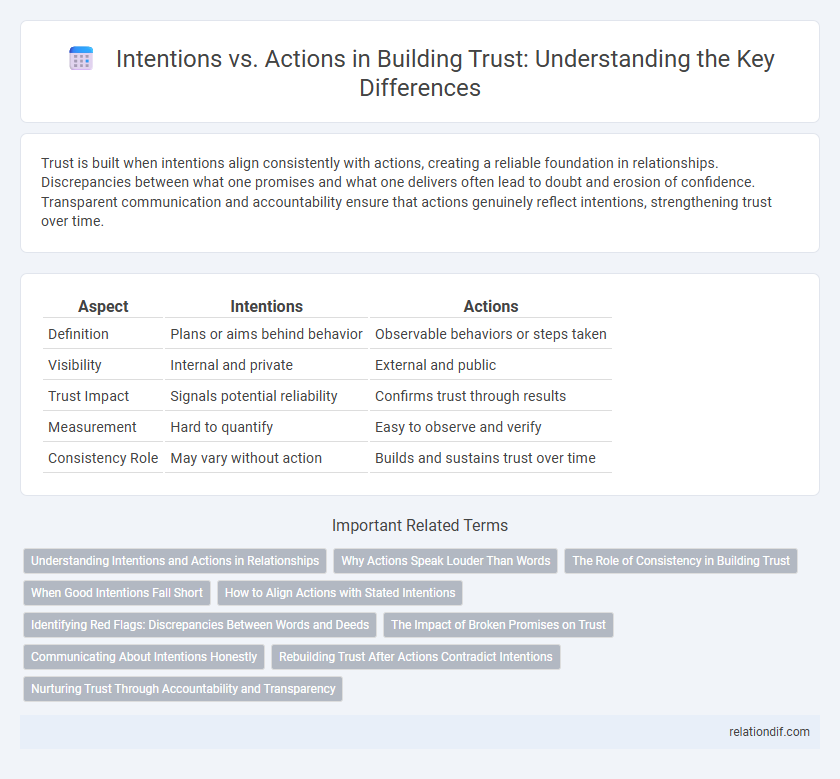Trust is built when intentions align consistently with actions, creating a reliable foundation in relationships. Discrepancies between what one promises and what one delivers often lead to doubt and erosion of confidence. Transparent communication and accountability ensure that actions genuinely reflect intentions, strengthening trust over time.
Table of Comparison
| Aspect | Intentions | Actions |
|---|---|---|
| Definition | Plans or aims behind behavior | Observable behaviors or steps taken |
| Visibility | Internal and private | External and public |
| Trust Impact | Signals potential reliability | Confirms trust through results |
| Measurement | Hard to quantify | Easy to observe and verify |
| Consistency Role | May vary without action | Builds and sustains trust over time |
Understanding Intentions and Actions in Relationships
Understanding intentions and actions is crucial for building and maintaining trust in relationships. Genuine intentions often reveal a person's true values and commitment, while consistent actions demonstrate reliability and integrity. Aligning intentions with actions fosters deeper emotional security and mutual respect between partners.
Why Actions Speak Louder Than Words
Actions reveal true intentions by demonstrating commitment and consistency, reinforcing trust more effectively than mere promises. Behavioral evidence surpasses verbal assurances, as consistent actions validate integrity and predictability. Trust builds when observable deeds align with stated intentions, ensuring reliability and accountability.
The Role of Consistency in Building Trust
Consistent actions aligned with clear intentions serve as the foundation for building trust in any relationship or organization. When behavior reliably matches communicated intentions, it creates transparency and predictability, reinforcing trustworthiness over time. Discrepancies between what is promised and what is delivered lead to doubt, undermining confidence and weakening the trust bond.
When Good Intentions Fall Short
Good intentions alone cannot build trust without consistent, transparent actions that demonstrate reliability and integrity. Misaligned intentions and behaviors often erode confidence, as stakeholders prioritize tangible deeds over promises. Effective trust-building requires aligning words with measurable outcomes to foster lasting credibility.
How to Align Actions with Stated Intentions
Aligning actions with stated intentions requires consistent self-reflection and accountability measures to ensure transparency and integrity. Establishing clear communication channels and setting measurable goals help bridge the gap between promises and tangible outcomes. Regular feedback loops and adapting behaviors based on results reinforce trustworthiness and credibility.
Identifying Red Flags: Discrepancies Between Words and Deeds
Discrepancies between intentions and actions serve as critical red flags in assessing trustworthiness. When individuals' words consistently conflict with their behavior, it signals potential deception or hidden motives. Monitoring these inconsistencies helps reveal insincerity and protect against manipulation in personal and professional relationships.
The Impact of Broken Promises on Trust
Broken promises severely damage trust by undermining the reliability and credibility of individuals or organizations. When actions contradict stated intentions, the perceived integrity deteriorates, leading to skepticism and reluctance to rely on future commitments. Consistent alignment between intentions and actions is essential to maintain and restore trust in any relationship or business context.
Communicating About Intentions Honestly
Honest communication of intentions builds trust by aligning expectations with actions, reducing misunderstandings and fostering transparency. Consistently expressing true intentions demonstrates reliability and accountability, which strengthens relationships over time. Clear, truthful dialogue about motives encourages openness and solidifies credibility in both personal and professional interactions.
Rebuilding Trust After Actions Contradict Intentions
Rebuilding trust after actions contradict intentions requires consistent transparency and accountable behavior to demonstrate genuine commitment. Clear communication addressing past discrepancies fosters understanding and helps repair damaged relationships. Trust restoration depends on sustained positive actions that align with stated intentions over time.
Nurturing Trust Through Accountability and Transparency
Nurturing trust requires aligning intentions with actions through consistent accountability and transparency, ensuring stakeholders can verify commitments are met. Transparent communication of decisions and processes reinforces credibility, while accountability mechanisms hold individuals and organizations responsible for outcomes. Demonstrating this alignment fosters stronger, more resilient relationships founded on genuine trust.
Intentions vs actions Infographic

 relationdif.com
relationdif.com